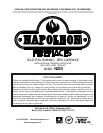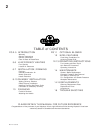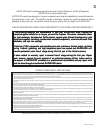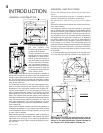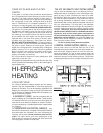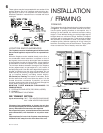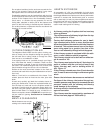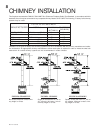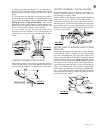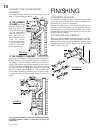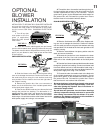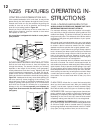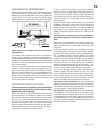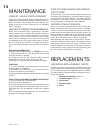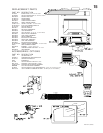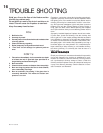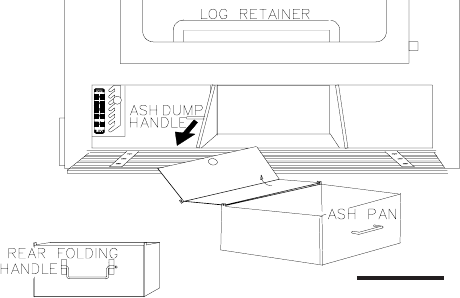
WS-415-71 / 09.07.00
13
ASH REMOVAL PROCEDURES
A bed of ashes approximately 1 inch deep should be left on
the firebox bottom to help maintain a hot charcoal bed.
When the fire has burned down and cooled, remove any
excess ashes. To use your ash pan, pull the ash dump
handle forward to an open position. Rake the excess ashes
over the grate and into the ash pan. Close the ash well.
Never operate your fireplace with the ash well in an
open position!
This creates a fire hazard that may result in a house/chim-
ney fire, internal damage to the stove or discoloration to
the gold plated door (plated finishes are not covered by the
warranty). To ensure that the ash well is fully closed, allow
the door to snap shut, dislodging anything that may be
stuck at the opening.
Flip the cover up onto the ash pan when transporting the
ashes to a closed container with a tight fitting lid for stor-
age. Carry the ash pan using the front and back handles.
Keep the closed container on a non-combustible floor or
ground, well away from all combustible materials. The
ashes should be retained in the closed container until all
cinders have thoroughly cooled. Cold wood ashes can be
used on the garden or compost.
OPERATING INSTRUCTIONS
Remove all source of gasoline or other flammable
vapours and liquids in the vicinity of this or other
appliances prior to lighting.
When first installed, the fireplace and the steel are cold
and must become hot before the fireplace will function
well. During the break-in period (the first 2 or 3 fires) create
only small, hot fires using kindling; this will allow the fire-
brick to cure. Do not be alarmed if small hairline cracks
develop in the firebrick. This is a normal occurrence and
does not pose a safety hazard. The paint may also smell a
little for the first few fires as it cures and you may wish to
open a door or window to alleviate the smell.
FIGURE 24
To start, a brisk fire is required. Place loosely crumpled
paper on the floor of the fireplace behind the log retainer
and cover with dry kindling. Open the draft control fully by
moving the lever to "HIGH". Light the paper and leave the
door slightly ajar (one inch) until all kindling is burning. To
maintain a brisk fire, a hot coal bed must be established
and maintained.
Slowly add larger wood (2x4 size pieces). Lay the pieces
lengthwise from side to side in the hot coal bed with a
shallow trench between, so that the primary air can flow
directly into this trench and ignite the fuel above. When the
fire seems to be at its peak, medium sized logs may be
added. Once these logs have caught fire, carefully close
the door.
Closing the door too quickly after refueling will reduce
the firebox temperature and result in an unsatisfactory
burn.
Remember it is more efficient to burn medium sized wood,
briskly, and refuel frequently than to load the fireplace with
large logs that result in a smouldering, inefficient fire and
dirty glass.
As soon as the door is closed, you will observe a change
in the flame pattern. The flames will get smaller and lazier
because less oxygen is getting into the combustion cham-
ber. The flames, however, are more efficient. The flames
will remain lazy but become larger again as soon as the
firebricks have been heated thoroughly and the chimney
becomes heated and provides a good draft. At this point,
the roaring fire that you see when the door is opened is
wastefully drawing heated room air up the chimney -- cer-
tainly not desirable. So always operate with the door fully
closed once the medium sized logs have caught fire.
You can now add larger pieces of wood and operate the
fireplace normally. Once the fireplace is entirely hot, it will
burn very efficiently with little smoke from the chimney. There
will be a bed of orange coals in the firebox and secondary
flames flickering just below the top of the firebox. You can
safely fill the firebox with wood to the top of the door.
Can't get the stove operating? Use more kindling and
paper. Assuming the chimney and vent are sized correctly
and there is sufficient combustion air, the lack of sufficiently
dry quantities of small kindling is the problem. Thumb size
is a good gauge for small kindling diameter.
Can't get heat out of the stove? One of two things may
have happened. The fireplace door may have been closed
prematurely and the fireplace itself has not reached opti-
mum temperature. Re-open the door and/or draft control to
re-establish a brisk fire. The other problem may have been
wet wood. The typical symptom is sizzling wood and mois-
ture being driven from the wood.



